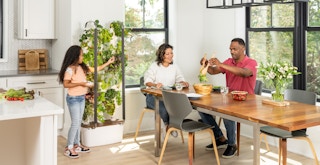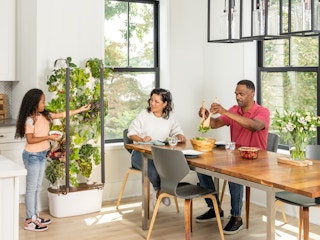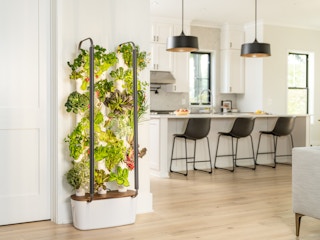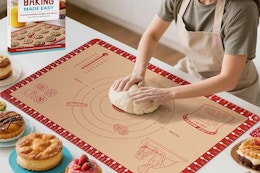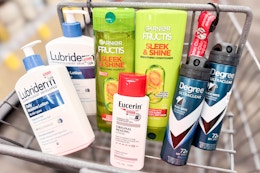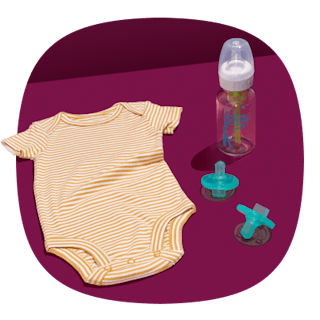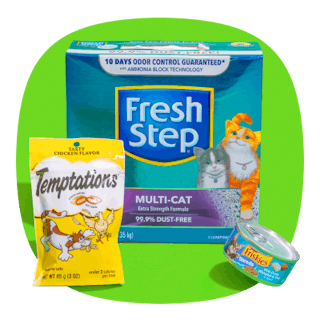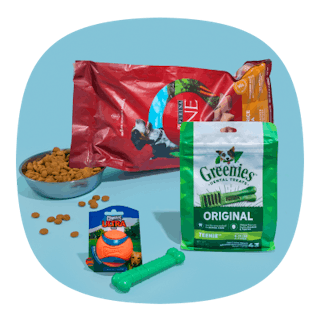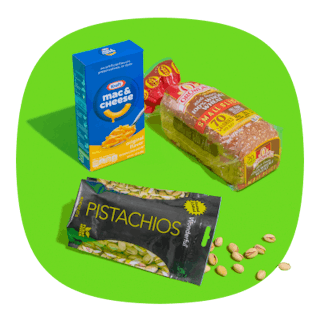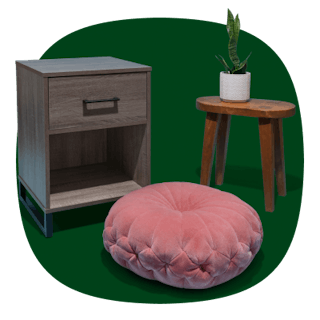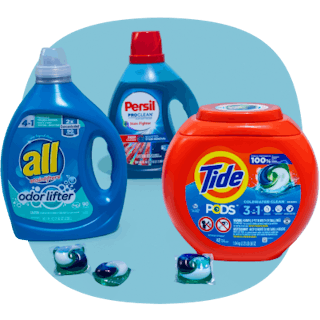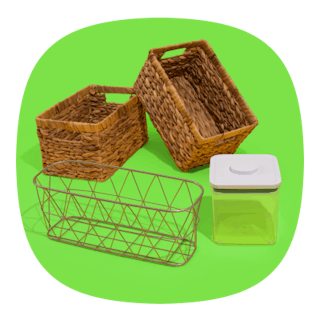With the rising costs of everything from eggs to orange juice, you may be considering some unique ways to save money on groceries. As prime examples, I’ve seen lists of affordable egg substitutions for cooking and cost breakdowns of owning a chicken coop. And I’m also considering the costs of growing my own produce at home. The most intriguing home garden I’ve come across (as a gardening novice) is the Gardyn system. I’ve done a little digging and this baby is pretty expensive, but I figure there have to be some ways to save money with Gardyn if I really put my mind to it.
For me, it comes down to calculating how much produce I purchase in a year and then figuring out how to plant enough to replace my grocery store produce with Gardyn. It’s worth pointing out that I enjoy cooking at home and I do it pretty often, but also have two children who can’t stand vegetables (yet). So while I’ve calculated my total produce cost estimate for the past year, yours may look different.
This is also a marathon and not a sprint. The plants take time to grow and you’ll still be shopping grocery store produce while you learn the ins and outs of hydroponic gardening. But, with a little research, planning, and a lot of homemade salads, you can definitely save money with Gardyn. Let’s dig into how to weigh the costs.
And for more money-saving hacks, download the Krazy Coupon Lady app.
First of all, what is Gardyn?
Gardyn is an AI-powered indoor vertical garden that allows users to grow nutrient-dense produce at home using patented Hybriponic technology. It is a self-contained hydroponic system developed for use inside the home and is designed to be super easy to use, with no gardening experience required. And, for the record, hydroponic is just the technical term for a method of growing plants without soil.
Now, here’s what is really cool: Gardyn can grow up to 30 plants and over 50 varieties on a very small footprint of just two square feet. It features advanced sensors and an energy-efficient pump that promotes plant irrigation, and an AI assistant named Kelby that monitors the system 24/7. Gardyn is sustainable, uses high-quality materials, and allows users to choose from a variety of organic, non-GMO plant seeds.
Not surprisingly, it’s beneficial to grow your produce at home.
Gardyn provides highly nutritious produce without pesticides or herbicides, so there’s none of the yucky stuff. Your homegrown plants can be consumed immediately after harvesting, ensuring 100% of their intended nutrition is received. In contrast, grocery store produce loses nutritional value from the moment of harvesting (no washing necessary!), with some fruits and vegetables taking weeks or months to reach stores (yikes!). Most produce loses 30% of its nutrients just three days after being harvested. Additionally, efforts to breed crops for greater yield, pest resistance, and climate adaptability have not kept pace with their rapid growth. Ultimately, this results in produce with reduced nutrient content. Instead, Gardyn gives you nutritious, home-grown, organic vegetables that you can serve directly from plant to table.
Sound interesting? Get Gardyn’s hybriponic 2.0 system for $595 right now.
Yes, this is steep. But they currently have 30% off and $100 off on top of that when you use our code KRAZY. So with all discounts combined, you’re essentially getting the $999 system at a 40% discount. Still, we get that may seem lofty for your budget.
Use the grocery calculator on Gardyn.com to estimate how much you’ll save.
Save the receipt from your next grocery trip. Gardyn has a convenient grocery calculator where you can estimate how much you spend on produce at the grocery store and see if the Gardyn system will help you save money. I will note that in your first year, you’re likely not going to see huge savings because you’ll need some time for the Gardyn to pay off its hefty up-front cost. By the second year, though, especially as inflation continues to raise grocery prices, your Gardyn will have more than paid for itself in produce.
Related: 10 Tips For Saving Big on Healthy and Organic Foods
Consider wasted food in your calculations.
While I didn’t break down the cost of waste in my spreadsheet, it was top of mind as I considered how much I was spending on fresh fruits and veggies. When I shop at the grocery store, I’m limited to buying produce in pre-measured portions. Sometimes I don’t need an entire bunch of cilantro, but just a few sprigs. Inevitably, no matter how hard I plan, some of that bunch of cilantro is going to end up being wasted. But with Gardyn, you harvest what you need, and nothing more. With the amount of food I waste trying to cook for two toddlers every night, that is a big positive point to me.
How to save money with Gardyn.
While we know that Gardyn may not pay for itself in produce the first year you have it, there are some ways to hurry the pay-back process along. Some planning and research on their plants can help you select the most cost-effective vegetables and fruits. This way you’re starting to save money on groceries more quickly. The best advice I can give is to be informed and diligent in your plant selection. Here’s how you can save money with Gardyn by selecting the right plants.
Create a spreadsheet (yes, really!) to create a personalized plant shopping list.
Okay, I love spreadsheets, but you don’t actually have to create one. Though I do recommend you at least grab a pen and paper to write down your family’s favorite produce. I found this to be a more personalized and detailed way to see how much I was spending on produce every month, so I could then calculate an annual estimate. Plus, it was an excuse to sit down with my family, discuss our favorite meals and foods, and overall have a great conversation about eating healthy foods we actually enjoy. Whether you’re using a spreadsheet or a notepad, write down the produce your family buys most often. This can be the start of your Gardyn shopping list.
Take this a step further and (this is why I chose to create a spreadsheet!) estimate how many times you purchase your favorite organic produce in a year. Next, multiply it by the cost of buying it at the grocery store. This should give you a rough projection of how much you’re spending on fresh produce annually. I estimated that I spend roughly $650 to $750 per year on fruits and veggies. The variation in cost depends on whether I buy organic and whether the items are on sale or at full price. Seeing this on paper started to make the cost of the Gardyn seem less intimidating.
Figure out which of your family’s favorite plants will save you the most money.
Now that you know your family’s favorites, here’s where you can do a little weeding (pun intended) to choose plants that are the most cost-effective. To get the most bang for your buck, choose plants that sprout quickly, mature quickly, and last several weeks. Greens and lettuce will sprout and mature the fastest. Herbs and plants, like tomatoes or strawberries, will take the longest to yield a harvest. So be selective, as they’re taking up precious growing room on your Gardyn.
I recommend growing as many greens and fast-growing veggies as possible to get the most out of the Gardyn system. However, since you can grow up to 30 plants, there is plenty of room for slower-growing varieties if they’re on your family’s love list.
Our picks for the most cost-effective Gardyn plants.
To avoid waste, I do recommend that you base your plant purchases on those your family will eat most often regardless of my recommendations. But these are the top picks for the most cost-effective plants that Gardyn sells. They are some of the quickest to sprout and mature when compared to other options, so you can enjoy more of these nutritious plants throughout the year. Gardyn has a bank of useful information about each plant, so you can read up before you buy.
I tried to select a mix of the quickest-growing and longest-lasting greens, fruits & vegetables, and herbs to give you a robust selection. If any of these made it to your family’s favorite produce list, definitely add them to your Gardyn cart. There are only 14 plants here, and Gardyn supports up to 30. So you can select an additional 16 plants that you want to grow that may not yield as much fresh produce within a year, or you can grow multiple plants of the same varieties.
Cost-Effective Gardyn Plants:
- Arugula: Sprouts in as little as 4 days; matures in 40 days; lasts 4-5 weeks
- Basil: Sprouts in as little as 5days; matures in 68 days; lasts 8-12 weeks
- Bok Choy: Sprouts in as little as 5 days; matures in 45 days; lasts 3-4 weeks
- Buttercrunch Lettuce: Sprouts in as little as 7 days; matures in 46 days; lasts 3-5 weeks
- Cucumbers: Sprouts in as little as 10 days; matures in 65 days; lasts 2-4 weeks
- Endive: Sprouts in as little as 5 days; matures in 48 days; lasts 4-5 weeks
- Green Beans: Sprouts in as little as 10 days; matures in 75 days; lasts 8-10 weeks
- Mustard Greens: Sprouts in as little as 5 days; matures in 40 days; lasts 4-8 weeks
- Matilda Lettuce: Sprouts in as little as 7 days; matures in 52 days; lasts 3-5 weeks
- Mini Cauliflower: Sprouts in as little as 5 days; matures in 60 days
- Red Sails Lettuce: Sprouts in as little as 7 days; matures in 40 days; lasts 4-8 weeks
- Rosemary: Sprouts in as little as 15 days; matures in 42 days; lasts 6-12 weeks
- Sweet Peppers: Sprouts in as little as 10 days; matures in 83 days; lasts 8-20 weeks
- Wheatgrass: Sprouts in less than 7 days; matures in 21 days; lasts 4 weeks
If you plan on replacing grocery store produce with your Gardyn, consider a Gardyn membership.
Unfortunately, plants don’t last a lifetime and they do eventually stop producing. A single Gardyn yCube of lettuce will produce three full heads of the greens, but then will need to be replaced. If you know you’ll be using Gardyn for years to come with the intention of replacing your grocery store produce, the most economical choice is to sign up for a Gardyn membership. Starting at $29 per month when you sign up for a two-year membership, members receive 10 monthly credits that can be used on new plants or food. Other monthly options are available (at a slightly higher cost) if you prefer not to be locked into the two-year agreement. With any of their memberships, you’ll also get access to Kelby, Gardyn’s AI gardening assistant. A few more perks include discounted yCube plants, free plant replacement for non-germinating plants, access to a vacation mode for your Gardyn, and additional sales and perks.
Download the KCL app to add and redeem coupons in store

